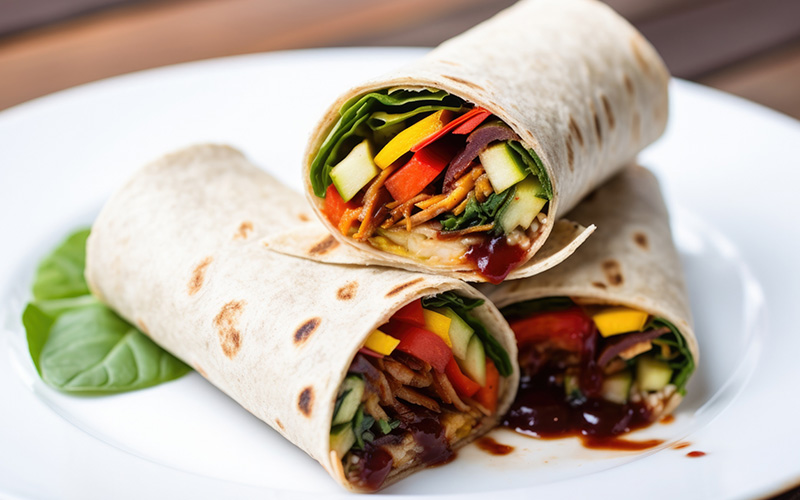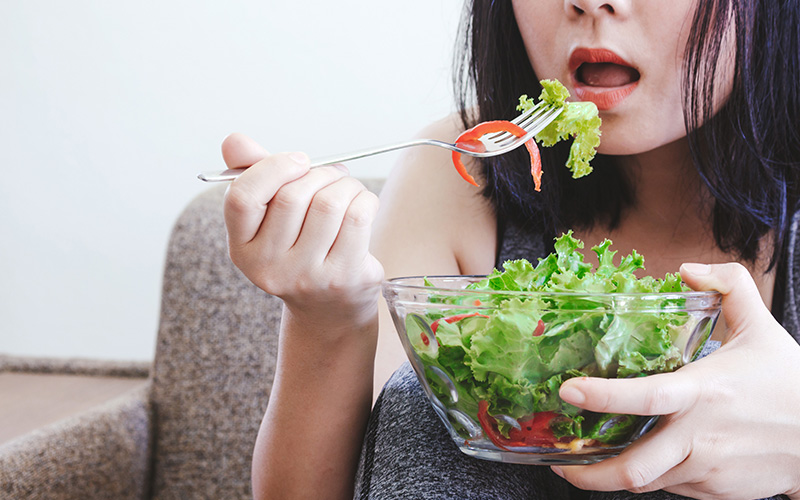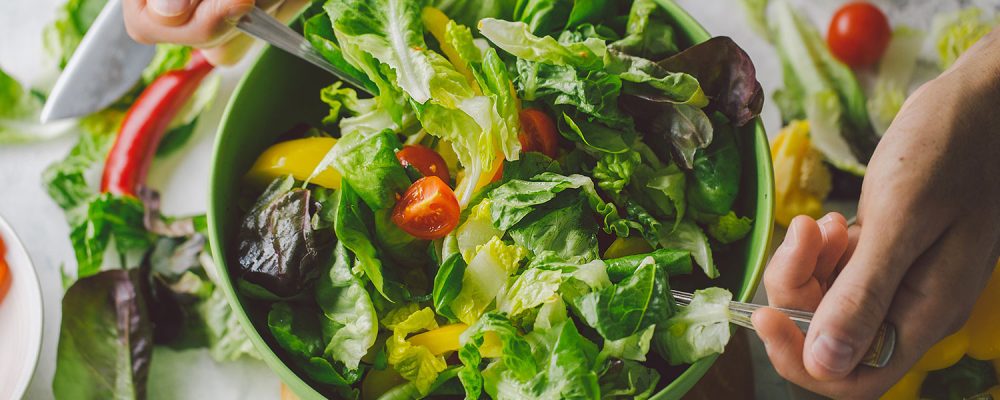There’s no doubt that adding more vegetables to your diet provides essential nutrition for your body.
However, the truth is that many people struggle to get more vegetables into their diet either because they either don’t really like them or don’t have much extra time to prepare them. In this article, we highlight some new and exciting ways to prepare vegetables and sneak them into your diet for better health and balanced nutrition.
15 Ways to Eat More Vegetables
Adding more vegetables to your diet is a great way to enhance your overall health and nutrition. Even if the thought of vegetables doesn’t make your mouth water, we’re certain that learning how to prepare them in tasty ways or adding them to things like smoothies and desserts just might change your mind. Let’s get started!
1. Sneak Them Into Smoothies
Incorporating vegetables into your diet through smoothies is always a clever strategy. To get started, select a suitable base like yogurt, milk, or fruit juice for your smoothie. The trick is to add mild-flavored veggies such as spinach, kale, cucumber, or carrots, so that they don’t overpower the yummy smoothie taste. If you’re new to this approach, begin with a modest amount of veggies and chop them into small pieces before adding to your blender.
Then, blend your vegetables with your base and preferred fruits (frozen ingredients can provide a creamier texture) until the mixture is smooth; the natural colors of the fruits will often conceal the green hue of veggies. If your smoothie needs a touch of sweetness, consider natural options like honey or agave nectar. Try ingredients like vanilla extract, cinnamon, or nut butter to enhance the taste. In addition, supplements like protein powder, chia seeds, or hemp seeds, can help boost nutritional value.
2. Add Them to Breakfast
Having vegetables for breakfast can be a nutritious start to your day — even frozen ones will work! Think about some of the vegetables you enjoy and how they might be compatible with common breakfast flavors. Maybe you could sauté some sweet bell peppers, onions, and spinach to create a savory omelet or scrambled with eggs or tofu? Or, how about blending some leafy greens like kale or spinach into your morning smoothie? You could always add a handful of berries and a banana for sweetness!
Some people like to grate zucchini or carrots into pancake or waffle batter for a delightful twist on a classic breakfast. Another option is to prepare a vegetable-packed breakfast burrito with scrambled eggs, black beans, salsa, and diced tomatoes wrapped in a whole-grain tortilla. Additionally, you could consider adding extra vegetables to your toast or bagel with cream cheese like a sliced tomato, avocado, or cucumber. These simple steps are easy ways to seamlessly sneak more veggies into your breakfast routine.
3. Make Chips!
Creating your own veggie chips (like kale chips!) can be a satisfying and healthy alternative to store-bought snacks.
Choosing Vegetables and Preparing for Baking
To begin, choose your favorite vegetables; options like sweet potatoes, zucchini, beets, or kale work great here. Preheat your oven to a low temperature, typically around 225°F (107°C). Wash and thinly slice your veggies, aiming for uniform thickness to ensure even baking. Pat the slices dry to remove excess moisture, which can make the chips soggy.
Seasoning and Baking Your Veggie Chips
Toss the slices in a bowl with a drizzle of olive oil and some seasonings, such as salt, pepper, paprika, or garlic powder. Arrange the slices in a single layer on baking sheets lined with parchment paper, ensuring they don’t overlap. Bake in the preheated oven for about 2-3 hours, flipping the chips halfway through until they become crisp and slightly golden. Keep an eye on them, as cooking times may vary depending on the thickness of the slices. Allow the veggie chips to cool before enjoying a homemade, crunchy, and nutritious snack that even kids
4. Put Them In Sauces
To complement veggie chips, a vegetable-based sauce can be an excellent choice for added nutrition. In fact, utilizing veggie-based sauces is a great idea for infusing your meals with flavor and nutrition.
Begin by selecting vegetables that complement your dish. For example, sweet bell peppers, tomatoes, and carrots work well for a versatile tomato sauce. You can also try sautéing onions and garlic in olive oil. Add your chosen veggies to the pan, letting them soften and release their natural sweetness. Blend the mixture until smooth, and you have a homemade, vegetable-rich pasta sauce.
Alternatively, you can experiment with pesto by combining fresh basil, garlic, pine nuts, parmesan cheese (or a vegan alternative), and olive oil in a food processor. To create a green goddess dressing, blend together avocado, herbs, and lemon juice. You can also try roasted red pepper sauce by charring red peppers and blending them with garlic, olive oil, and spices.
5. Create Veggie Wraps

Besides veggie chips, crafting veggie wraps is another great way to incorporate fresh vegetables into your meals. You can start by selecting your preferred wrap base, such as whole grain tortillas, collard greens, or rice paper sheets. Lay out your chosen base and add a spread of your choice, like hummus, tahini, or Greek yogurt. Next, add an assortment of veggies, like bell peppers, cucumbers, carrots, lettuce, avocado, and more.
You can also add protein sources like grilled chicken, tofu, or chickpeas for a heartier wrap. Some also add a sprinkle of herbs, such as cilantro or basil for an extra burst of flavor. Then, roll the wrap up tightly, tucking in the sides as you go, to create a neat and compact package. You can enjoy your veggie wrap as-is or cut it into smaller portions for bite-sized servings. To optimize your veggie game, you can also try other veggie wraps, including lettuce wraps, for added nutritional health benefits.
6. Try Vegetable-Based Soups
Exploring vegetable-based soups is a comforting and wholesome way to get your veggies in.
To begin, choose your favorite greens, including leftover vegetables or those in season for fresh and vibrant flavors. Start by chopping them into bite-sized pieces for uniform cooking. In a large pot, heat some olive oil or butter, sauté diced onions and garlic until they become fragrant and translucent.
Then, add the chopped greens to the pot and cook for a few minutes. It gives enough time for the ingredients to release their flavors. Pour in vegetable or chicken broth to cover the vegetables and bring the mixture to a boil. Reduce the heat to a simmer, cover the pot, and let it cook until the vegetables are tender. You can add herbs and spices like basil, thyme, or paprika for more flavor. Once the greens are cooked to your desired level of tenderness, puree it with an immersion blender or transfer the soup to a blender to puree it until smooth. Season with salt and pepper to taste and serve hot.
7. Prepare Colorful Salads
Colorful salads can be visually appealing, nutritious meals. Start selecting a variety of fresh and colorful vegetables like bell peppers, cherry tomatoes, cucumbers, and carrots. Wash and chop them into bite-sized pieces. Next, add a base of leafy greens like spinach, arugula, or mixed greens. Some people also love to stuff different types of lettuce to fill their bowl. On top of that, you can mix multiple ingredients like fruits, nuts, and cheese to enhance the flavor.
Then, create a homemade dressing with olive oil, vinegar, mustard, and honey. Drizzle the dressing over your salad and toss everything gently to ensure an even distribution of flavors. You can add protein and customize your colorful salad to different tastes, making it a delicious and healthy addition to any meal.
8. Put Them on Pizza!

Furthermore, if you’re not a fan of salads and prefer indulging in pizza, you can still get your vegetables in by trying pizzas with veggie toppings. Start by selecting a pizza crust — whether it’s homemade dough, store-bought, or even a cauliflower crust, which is a great low-carb option. Then, choose your base sauce, typically tomato sauce or pesto, and spread it evenly over the dough/crust.
Now comes the fun part! It’s time to decorate the base layer with an assortment of colorful veggies. Bell peppers, onions, mushrooms, zucchini, cherry tomatoes, and spinach are a few common options that work well here. Feel free to be as creative and experimental as you like with the combinations. Remember to sprinkle some shredded cheese on top, like mozzarella, feta, or goat cheese. Then, bake your pizza in a preheated oven until the crust is golden and the cheese is bubbling. Once out of the oven, consider adding fresh herbs like basil or arugula for an extra burst of flavor.
9. Make Noodles with Them
Making noodles with veggies is another great way to get some vegetables into your diet. To get started, choose your vegetables. Cauliflowers, zucchini, sweet potatoes, or carrots are popular options to try. You can also mix multiple veggies together. To start the process, wash and peel the vegetables. If desired, use a spiralizer or a julienne peeler to create noodle-like strips. If you don’t have a spiralizer, you can also use a knife to carefully slice thin, long strips.
Heat a pan with a bit of olive oil over medium high heat. Next, sauté the veggie noodles for a few minutes until they’re tender but still slightly crunchy. You can season them with salt, pepper, and your preferred herbs or spices. Then, add some sauce before serving the veggie noodles — marinara, pesto, or alfredo are some delicious sauces to consider. At the end, add proteins like grilled chicken or shrimp for a complete meal. If you’re not a fan of veggie noodles but still want to enjoy traditional pasta dishes like lasagna, you could always make zucchini lasagna for another healthy option.
10. Blend Them into Dips
Blending vegetables into dips is another way to add some nutritional goodness to your snacks or appetizers. Begin by selecting the vegetables you’d like to use — options like roasted red peppers and artichokes work well. Then, prepare and cook the veggies by roasting or steaming them to achieve a soft and flavorful texture. Once cooked, add the veggies to a food processor or blender, along with your choice of ingredients to create a creamy base. This may include cream cheese, Greek yogurt, sour cream, or a combination of them.
In addition, adding spices, garlic, and herbs can improve the taste. Blend everything until smooth, adjusting the consistency with a bit of olive oil or water as necessary, add some seasonings to your liking, and serve with crackers, bread, or fresh-cut veggies.
11. Grill Or Roast Them

Grilling or roasting veggies brings out their natural flavors and can deliver a satisfying smokiness or caramelization. It’s actually one of the more popular ways of eating veggies!
To begin, choose your favorite vegetables like bell peppers, zucchini, eggplant, or cherry tomatoes. Wash and cut them into manageable pieces, ensuring they are all of uniform size for even cooking. Preheat your grill or oven to the desired temperature. Typically, it should be around 400°F (200°C) for roasting or medium-high heat for grilling.
Next, toss the veggies in olive oil. Then, season with salt, pepper, herbs or spices — rosemary or thyme are great options. Lay the vegetables out in a single layer on a grill grate or a baking sheet lined with parchment paper. Grill or roast until they become tender and develop a charred or slightly browned appearance (about 20 to 30 minutes). Be sure to turn them occasionally for even cooking. Once they’re done, you can drizzle some balsamic vinegar glaze or sprinkle some grated parmesan cheese for added flavor.
12. Stuff Them
Stuffing green veggies is a versatile and flavorful cooking technique that transforms ordinary veggies into satisfying dishes. To begin, select veggies that are suitable for stuffing, such as bell peppers, tomatoes, zucchini, or eggplant. Carefully cut off the tops and hollow out the insides, removing seeds and membranes as needed to create a hollow cavity. This cavity is where you’ll add the filling. Prepare a tasty stuffing mixture by combining ingredients like cooked rice, quinoa, or breadcrumbs. People also stuff vegetables with proteins such as ground meat, tofu, or beans.
Then, sauté chopped onions, garlic, and leafy greens, and add herbs, spices, and grated cheese to enhance the flavor of the filling. Once the stuffing mixture is ready, generously fill the hollowed-out veggies with it, pressing down gently to pack the filling. Place the stuffed veggies in an oven-safe dish, drizzle with olive oil or sauce, and bake until the veggies are tender and the stuffing is cooked through. It is a much better option than other ways to get so many green veggies at once while the taste is also different from regular meals.
13. Make Snack Packs
Creating veggie snack packs is a convenient and nutritious way to get some on-the-go nutrition. Start by selecting an assortment of fresh veggies like carrots, celery, cherry tomatoes, cucumber slices, and bell pepper strips. Wash and cut them into bite-sized pieces, and then portion them out into snack-sized bags and pair them with a flavorful dip or dressing such as hummus, tzatziki, or ranch.
To keep the veggies crisp, consider keeping them packed together with a small ice pack. These portable packs are an effortless way to ensure you have a nutritious option readily available when hunger strikes.
14. Pair Them with Main Dishes
Pairing vegetable sides with main dishes is another great way to add more nutrition to your meals. For instance, roasted brussels sprouts pair wonderfully with a hearty steak, while garlic sautéed spinach is a lovely compliment to a light fish dish. Wash and prepare the vegetables by trimming or chopping them into your desired size and shape. To enhance their taste, season them with olive oil, salt, pepper, and any desired herbs or spices, such as rosemary, thyme, or garlic powder.
Depending on the chosen vegetables, including frozen cauliflower, you can cook veggies in the air fryer, roast them in the oven, sauté them on the stovetop, or even grill them. Keep an eye on their cooking time to achieve the perfect texture — crispy or tender, depending on your preference. Once done, arrange the vegetable sides on a serving plate and garnish with fresh herbs or a drizzle of balsamic glaze for added flavor and presentation. Vegetable sides not only elevate the overall dining experience but also contribute essential nutrients to your meal. It may become as valuable as your main course, depending on the diet plan.
15. Make Desserts
Sneaking some veggies into your desserts is a creative way to incorporate vegetables into your meals. You’ll want to begin by selecting vegetables that blend seamlessly with sweet flavors, like baby carrots, zucchini, sweet potatoes, or beets. Wash, peel, grate, or finely puree them to incorporate into classic recipes like carrot cake, zucchini bread, or sweet potato pie.
The great thing is that the natural sweetness of these veggies can reduce the need for excessive sugar. Don’t forget to add your favorite nuts, dried and frozen fruits, or chocolate chips for added texture and indulgence — and some comforting spices like cinnamon or nutmeg.
Why Should You Eat More Vegetables?

Vegetables are an easy and effective way to improve your overall health. They’re nutrient-packed superstars that are low in calories and high in fiber, which can help you manage your weight and keep your digestive system happy. Eating veggies regularly can also lower your chances of getting serious diseases like heart problems and certain types of cancer, thanks to their natural inflammation-fighting powers. Let’s take a deeper dive into the important benefits of vegetable consumption:
Key Benefits of Eating More Vegetables
Nutrient Rich: Vegetables come with necessary vitamins, minerals, and antioxidants. These are vital for various bodily functions. They may provide immune support, bone health, and skin maintenance.
May Support Weight Loss: Vegetables are typically low in calories and high in fiber. Thus, veggies may make you feel less hungry and help support weight management by promoting feelings of fullness and reducing calorie intake. [1]
Might Aid in Disease Prevention: Regular consumption of vegetables may be linked to a reduced risk of chronic conditions such as heart disease, certain types of cancer, and diabetes, due to disease-fighting antioxidants and anti-inflammatory properties. [2]
Can Possibly Improve Digestive Health: The fiber in vegetables may help promote healthy digestion by preventing constipation and supporting a balanced gut microbiome.
May Assist in Hydration: Many vegetables, such as cucumbers and celery, have high water content, which may help to keep you hydrated, especially in hot weather.
Might Improve Eye Health: Carrots and kale are rich in beta carotene and lutein, which can support good vision and may reduce the risk of age-related eye conditions.
Can Possibly Enhance Skin Health: The vitamins and antioxidants in vegetables can help promote healthy skin by protecting against UV damage and may slow down the aging process.
May Boost Bone Health: Vegetables like broccoli and kale provide essential nutrients like calcium and vitamin K, which are important for bone strength.
May Assist in Improved Mood: A vegetable-rich diet may have been associated with better mental health and could possibly reduce the risk of depression.
Versatility: Vegetables can be prepared in numerous ways, making it easy to incorporate them into various dishes and cuisines, ensuring a diverse and enjoyable diet.
Which Vegetables Are Best for You?
The world of vegetables is a diverse and colorful one. Here’s a list of the health benefits of some of the more popular veggies:
Spinach: Packed with iron, vitamins A, C, and K, and folate, this ingredient is excellent for overall health, including dietary fiber intake as well as bone strength.
Kale: An antioxidant powerhouse, kale is rich in vitamins A, C, and K and is known for its anti-inflammatory properties.
Broccoli: Loaded with fiber, vitamin C, and phytonutrients, broccoli is renowned for its cancer-fighting abilities.
Sweet Potatoes: A great source of beta-carotene, fiber, and vitamins A and C, sweet potatoes may support eye health and immunity.
Bell Peppers: Rich in vitamin C and antioxidants, bell peppers aid in skin health and immune support.
Tomatoes: Tomatoes contain lycopene, which is linked to heart health, along with vitamins A and C.
Carrots: Carrots are high in beta-carotene, known for promoting good vision and immune function.
Brussels Sprouts: Packed with fiber, vitamins K and C, and antioxidants, brussels sprouts may support digestive health and overall immunity.
How Many Servings of Vegetables Should You Consume Per Day?
The general guideline is to aim for at least five servings of vegetables per day. However, the ideal quantity may vary based on your age, gender, dietary requirements, activity level, and health status. Nevertheless, striving for a minimum of five servings daily ensures a diverse intake of nutrients and health advantages from a range of vegetables. Here are some general guidelines for vegetable consumption tailored to different diets:
| Diet Plan | Daily Servings of Vegetables |
| Keto | 2-3 servings |
| Vegan | 6-8 servings |
| Paleo | 4-6 servings |
| Atkins | 3-5 servings |
Bottom Line
In conclusion, vegetables are key to a healthy diet because they contain many different nutrients that can improve your health in a variety of ways.
Whether they’re blended into smoothies or added to deliciously crafted wraps, there are so many ways to incorporate vegetables into your diet right now. With the power to boost your immune system, support weight management, and help reduce the risk of chronic diseases, there’s every reason to embrace these nutrient-packed treasures and get your health soaring to new heights.
Reference
- Lowry, R., Lee, S. M., McKenna, M. L., Galuska, D. A., & Kann, L. K. (2008). Weight Management and Fruit and Vegetable Intake Among US High School Students. Journal of School Health, 78(8), 417-424.https://doi.org/10.1111/j.1746-1561.2008.00324.x
- Oguntibeju, O. O., Truter, E. J., & Esterhuyse, A. J. (2013). The role of fruit and vegetable consumption in human health and disease prevention. Diabetes Mellitus-Insights and Perspectives, 3(2), 172-180.https://dx.doi.org/10.5772/3038
RV Team
* Reviewology is in partnership or collaborates with top brands highlighted on this site, including those occupying the top ranking positions.
Additionally, we earn affiliate commissions from products showcased on this website when you make a purchase through the provided links on Amazon or the company website directly.
We appreciate your support using our links to purchase your favorite brands or newly discovered brands.
Latest updates
I Thought I’d Always Feel Tired, Fat, and Forgotten—Until This
310 Greens vs AG1
The Truth About 310 Greens: A No-Nonsense Review of This Popular Supplement
Popular
I Thought I’d Always Feel Tired, Fat, and Forgotten—Until This
310 Greens vs AG1
The Truth About 310 Greens: A No-Nonsense Review of This Popular Supplement
© 2024 Reviewology. All Rights Reserved.
